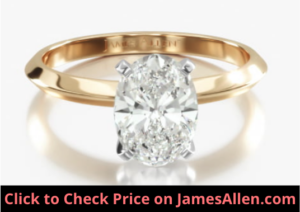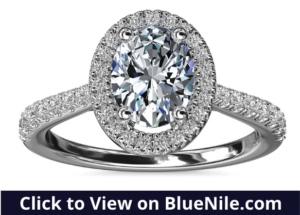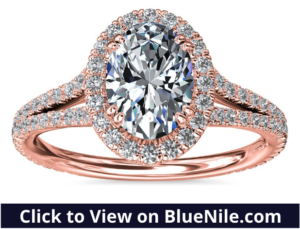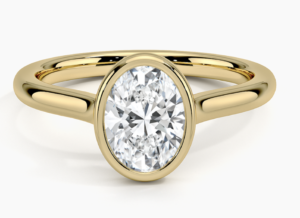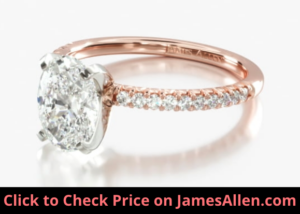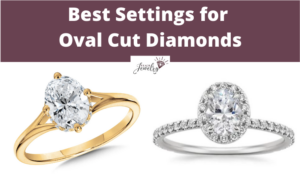
Oval cut diamonds are a popular choice for engagement rings.
They mimic the traditional round-cut but have a slightly wider width in one direction, offering an alternative to the classic style that still exhibits exceptional brilliance.
But the setting you choose also impacts its aesthetic and performance.
Here are six types of settings you should consider for oval cut diamonds.
1. Solitaire
Solitaire settings earn their name by including no diamonds other than the one at its center.
If there are any accents lining the shank, surrounding the center gem, or placed inside in the band, it isn’t a solitaire.
The reason solitaire settings are fit for oval cuts is because the diamond’s facets are shaped in a way that almost maximizes the amount of light it collects and returns to the viewer.
I say “almost” because no cut matches the brilliance of a round cut, but ovals are close.
If you’ve chosen a step-cut diamond such as Asscher or emerald that exudes a warm glow instead of white light, you might want to compensate for it with additional diamonds on the piece.
But oval cut diamonds are fit to stand on their own and still create an exceptional piece of jewelry.
For example, check out this oval cut in a 14K yellow gold setting.
It’s placed in a solitaire knife edge setting.
The thin band also increases the apparent size of the stone.
But just because it’s a solitaire setting doesn’t mean there isn’t room for unique features.
To illustrate, this oval cut is held by an entwined celtic love knot design.
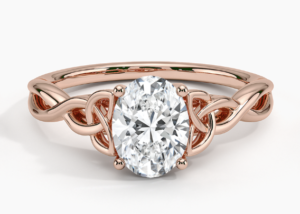 In both cases, the center diamond commands the most attention instead of being crowded out by other gems around it.
In both cases, the center diamond commands the most attention instead of being crowded out by other gems around it.
2. Halo
The distinguishing trait of a halo setting is the ring of small diamonds that surround the main one.
It’s a popular choice for any cut but especially oval diamonds.
The accents perfectly complement the rounded shape of the center diamond and give it a new outline.
One of the advantages is it gives the appearance of a larger diamond. In some cases, the halo blends in with the middle diamond and causes them to appear as one.
But if you look closely, there’s a clear contrast between each layer.
As an example, here’s an oval cut with a halo setting in 14K white gold.
There are 48 round-cut diamonds that form the halo. With an average color grade of I and clarity of SI2, it’s likely they appear colorless and flawless to the naked eye.
Combined with a one-carat oval cut that’s also eye-clean, it creates a stunning ring.
Another upside of halo settings is they increase the total carat weight of the piece without a significant price increase.
For example, the price difference between a solitaire and halo setting is often less than $1,000.
But if you added the same total carat weight from the halo to the center diamond — say, 0.30 carats — it’d often cost much more than that.
This is because the total price is lower if the carat weight is split between multiple diamonds compared to if it’s contained within one.
If you’ve opted for a halo setting for your oval cut, there are many options.
You could choose one that also includes accents on the ring, such as this split-shank.
The additional diamonds and split shank draw attention away from the oval cut, but the overall design is appealing.
3. Bezel
Bezel settings feature a ring of metal around the center diamond.
Here’s an oval cut with a bezel setting in 18K yellow gold.
Notice how it wraps all the way around the diamond and mimics its shape.
Here’s how it appears from the profile view.
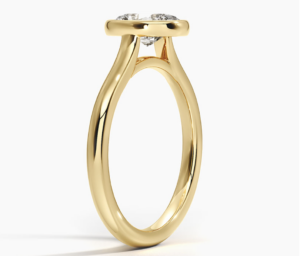
As you can see, the setting raises the diamond above the diamond above the ring, where it’s encapsulated by the bezel to hold it in place.
In fact, that’s the primary advantage of this style — security.
The oval cut is better protected from bumps and hits because the bezel acts as a layer of security before the diamond is impacted.
The downside is it doesn’t expose as much of the diamond as a prong setting. The lip covers the edges of the diamond, leaving on the crown visible from the face-up view.
So in comparison, it exhibits less brilliance.
You’re substituting a small degree of light performance for protection and its elegant aesthetic.
There are variations of bezel settings that are each fit for oval cuts.
For example, you could choose a partial bezel.
Instead of wrapping the full diamond, it leaves two sides exposed. As you’ve probably guessed, it offers less security but exposes more of the gem.
4. Pavé-Set
The word “pave” is derived from the French word that means “paving,” because a row of diamonds appears paved down the ring.
The accents are held in place by tiny prongs or beads that are often invisible to the naked eye. It provides the illusion the ring is created with a line of gems.
In most cases, pave diamonds weigh less than 0.02 carats. If they weigh 0.01 carats or less, it’s referred to as micro pave.
The reason pave settings work with oval cuts is because they add more sparkle to the piece.
Oval cuts already display strong brilliance, but if you want the entire ring to sparkle when it’s twirled, a pave setting accomplishes this.
For example, this 14K rose gold setting features petite pave with an oval cut.
On the vendor’s website, rotate the image 360 degrees, and notice its glimmer.
Twenty small diamonds, which total 0.16 carats, run halfway down the shank. With an average color of G-H and clarity of VS2-SI1, they’d be colorless and flawless without magnification.
Similar to a halo setting, pave is an effective way to increase the total carat weight and brilliance without the same price increase you’d expect from a larger center diamond.
The above setting is $1,020. As a comparison, you can expect to pay between $450 – $600 for the same type of solitaire setting.
If you’re interested in a setting that’s an alternative to the classic solitaire but still has a simple, elegant appearance, I recommend pairing your oval cut with a pave setting.
5. Six-Prong
Prong settings are the most popular design. You’ll find variations ranging from three-, four, and six-prong settings.
If you’ve chosen an oval cut, I recommend exploring six-prong settings.
To illustrate, here’s an oval cut with this style.

The elongated diamond is held by equidistant prongs.
One is placed on each end, and then there are two on each side.
The reason it’s one of the best settings for oval cuts is it offers a balance of security and visibility.
It’s held by enough prongs to secure it tightly in place, but it also doesn’t cover up too much of its crown and table.
As comparisons, here are two oval cuts held by four- and eight-prong settings.

Compared to a four-prong setting, you likely won’t notice any difference in light performance by adding two extra.
It creates a tight, cohesive appearance that doesn’t distract from the center diamond.
You can also combine a six-prong setting with other styles. For example, you can line the ring with pave- or channel-set diamonds.
If you choose a halo, it will likely hide the appearance of the prongs, so the feature won’t stand out as much.
6. Three-Stone
Three-stone settings often feature a single diamond in the middle, surrounded by smaller ones on each side.
One of the most popular variations includes tapered baguettes. While baguette diamonds are typically rectangular with straight edges, the tapered version has one end longer than the other, and its sides taper down toward that shorter end.
Here’s an engagement ring with an oval cut in the middle with tapered baguettes.
It’s an exceptional way to place multiple cuts on your ring in a way that doesn’t distract, but instead complements, you main diamond.
But tapered baguettes aren’t the only three-stone option.
On the left, the setting has two pear-shaped sapphires on each side of the oval cut, and one of the right, there are pavé diamonds halfway down the shank that lead up to two princess cuts.
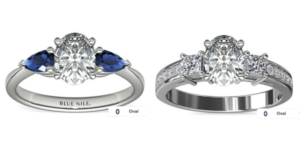
This demonstrates the variety of designs available when you choose a three-stone setting for your oval cut.
When selecting a prong setting for an oval cut diamond, it's not just about the immediate allure. We advise considering the wearer's daily activities. For those with active lifestyles, a setting that offers both grace and grip, like a six-prong setting, provides peace of mind without compromising on elegance. It’s the synergy of design and practicality that protects the stone’s beauty over a lifetime of wear.
Chuck Harris Tweet
Oval Cut Diamond Settings Q&A
Q: How does the length-to-width ratio of an oval cut diamond affect its appearance in different settings? A: The length-to-width ratio of an oval cut diamond can significantly impact its appearance. A higher ratio results in a more elongated shape, which can accentuate the finger’s length when set in a ring. Different settings may complement different ratios; for instance, a halo setting can balance an elongated diamond, while a shorter ratio might look more harmonious in a simple solitaire.
Q: Can the orientation of an oval cut diamond (vertical vs. horizontal) in a setting change the ring’s visual impact? A: Yes, the orientation of an oval cut diamond can alter the ring’s appearance. A vertical (or north-south) setting can elongate the finger, while a horizontal (or east-west) setting offers a more contemporary and unique look. The choice of orientation can also influence the perceived size and balance of the diamond on the band.
Q: What are the benefits and drawbacks of combining an oval cut diamond with a tension setting? A: A tension setting, where the diamond is held in place by the pressure of the band’s ends, can provide a modern, sleek look and allow more light into the diamond, potentially enhancing its sparkle. However, this setting may offer less protection to the diamond than bezel or prong settings and may require a custom band adjustment for resizing.
Q: How does the presence of additional accent stones affect the maintenance and longevity of oval diamond settings like pave or halo? A: Settings with accent stones may require more careful maintenance, as the small stones can become loose over time. Regular check-ups with a jeweler can ensure the stones remain secure. The longevity of the setting can be impacted by the wearer’s lifestyle and the care taken to maintain the ring.
Q: Are certain types of prong shapes or materials recommended for oval diamonds to enhance security and aesthetics? A: Rounded or V-shaped prongs are often recommended for oval diamonds as they can protect the tips of the stone, which are points of potential vulnerability. The choice of material, typically platinum or white gold for its strength and minimal maintenance, can also enhance the diamond’s security without detracting from its aesthetic appeal.
Q: How might the choice of an oval cut diamond setting differ for an engagement ring versus a pendant or pair of earrings? A: For an engagement ring, the setting should balance aesthetic appeal with practicality and protection, as it is worn daily and may be subjected to knocks. For pendants or earrings, the setting can often be more delicate or intricate since these pieces are less likely to encounter rough wear.

Jacob Clarke
Jacob Clarke is the founder of TeachJewelry.com.
He earned an Applied Jewelry Professional Diploma from the Gemological Institute of America (GIA) and now brings you essential information about diamonds, settings, and more.
Jacob has consulted with leading jewelry brands, and his work has been cited in Clean Origin, Diamond Nexus and industry publications.
He's also a member of the International Gem Society.
He enjoys discussing jewelry with readers, so contact him with any questions at jacob.clarke@teachjewelry.com.

